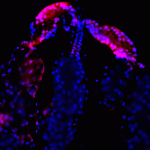Lien vers Pubmed [PMID] – 31243123
Lien DOI – e00705-1910.1128/JVI.00705-19
J Virol 2019 09; 93(18):
Aedes aegypti mosquitoes are the main vectors of arthropod-borne viruses (arboviruses) of public health significance, such as the flaviviruses dengue virus (DENV) and Zika virus (ZIKV). Mosquitoes are also the natural hosts of a wide range of viruses that are insect specific, raising the question of their influence on arbovirus transmission in nature. Cell-fusing agent virus (CFAV) was the first described insect-specific flavivirus, initially discovered in an A. aegypti cell line and subsequently detected in natural A. aegypti populations. It was recently shown that DENV and the CFAV strain isolated from the A. aegypti cell line have mutually beneficial interactions in mosquito cells in culture. However, whether natural strains of CFAV and DENV interact in live mosquitoes is unknown. Using a wild-type CFAV isolate recently derived from Thai A. aegypti mosquitoes, we found that CFAV negatively interferes with both DENV type 1 and ZIKV in vitro and in vivo For both arboviruses, prior infection by CFAV reduced the dissemination titer in mosquito head tissues. Our results indicate that the interactions observed between arboviruses and the CFAV strain derived from the cell line might not be a relevant model of the viral interference that we observed in vivo Overall, our study supports the hypothesis that insect-specific flaviviruses may contribute to reduce the transmission of human-pathogenic flaviviruses.IMPORTANCE The mosquito Aedes aegypti carries several arthropod-borne viruses (arboviruses) that are pathogenic to humans, including dengue and Zika viruses. Interestingly, A. aegypti is also naturally infected with insect-only viruses, such as cell-fusing agent virus. Although interactions between cell-fusing agent virus and dengue virus have been documented in mosquito cells in culture, whether wild strains of cell-fusing agent virus interfere with arbovirus transmission by live mosquitoes was unknown. We used an experimental approach to demonstrate that cell-fusing agent virus infection reduces the propagation of dengue and Zika viruses in A. aegypti mosquitoes. These results support the idea that insect-only viruses in nature can modulate the ability of mosquitoes to carry arboviruses of medical significance and that they could possibly be manipulated to reduce arbovirus transmission.




